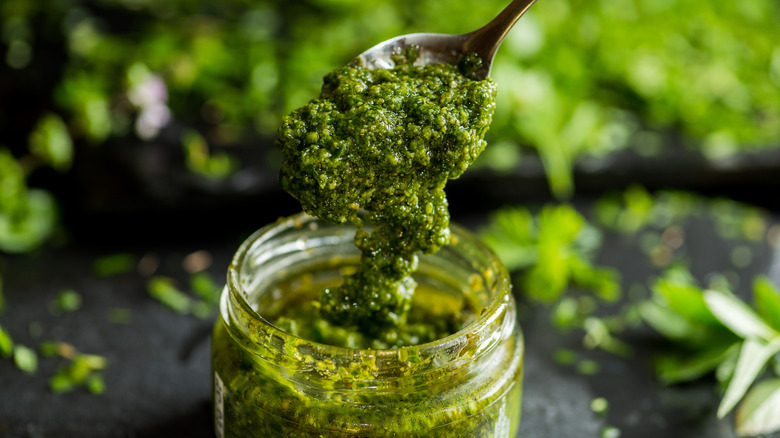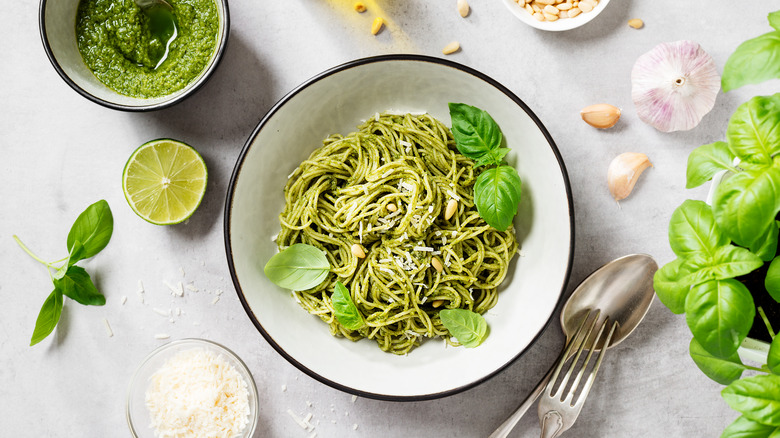Chimichurri Sauce Vs. Pesto: What's The Difference?
Both pesto and chimichurri are bright green sauces packed with fresh herbs, garlic, and olive oil, but the two condiments are quite different in a couple main areas. For starters, they rely on different herbs and other ingredients, and so they have markedly different flavor profiles. Chimichurri has a vinegary bite to it while pesto is loaded with the salty umami that comes from Parmesan cheese. The two differ in texture as well. Classic chimichurri is coarser and chunkier, whereas pesto is thicker (due to the addition of nuts) with a somewhat smoother finish and mouthfeel.
When it comes to their applications, the two are used in largely similar ways. Are they interchangeable, though? That depends entirely on how you plan to use the sauce. No matter what you start with, using pesto often turns a finished recipe into a pesto dish — thanks to its strong flavor that steals the show. Chimichurri is used more as an accompaniment, although it will add a powerful pungency and hint of spice to whatever you choose to pair it with. It enhcnaces any dish.
What is pesto?
Pesto's birthplace is Liguria, a northwestern region of Italy, known for its basil growing and production of the sauce. Nowadays, pesto is often made in a blender or food processor, but the classic Italian preparation involves a mortar and pestle and just a handful of fresh ingredients. Pine nuts, garlic cloves, and salt are mashed to form a paste and bright basil leaves and olive oil are added and smoothed together. Fresh Parmesan is folded in as the last step. Nowadays pesto is sometimes made with different nuts and additions, but authentic pesto lets the simple ingredients shine the best.
Pesto is a pretty versatile sauce. It stands on its own as a dip. It's also a vibrant summer sauce for pasta, as it can take the place of marinara on a pizza or a smear of mayonnaise on a sandwich. Pesto is delicious swirled into scrambled eggs, on top of a baked potato or roasted vegetables, as the dressing for a pasta or potato salad, or simply dolloped atop a piece of salmon or chicken. Its applications are endless — if you like garlic, basil, and cheese, you're pretty safe adding pesto to just about anything.
What is chimichurri sauce?
Chimichurri is a tangy Argentine sauce, a classic condiment for grilled meats. The sharpness of the vinegar nicely cuts the fatty richness of barbecued meat. There are a couple theories as to where the name chimichurri comes from. One is that it is borrowed from the Basque word tximitxurri for an herb sauce, which is pronounced just like chimichurri. Some believe it came from an Irishman named Jimmy McCurry who whipped up a sauce to take the place of his beloved Worcestershire sauce after moving to Argentina. The legend is that the locals gave it his name and their pronunciation sounded like chimichurri.
There are many variations of chimichurri, but the more classic version involves fresh parsley, fresh oregano, garlic, red wine vinegar, olive oil, crushed red pepper, and salt. Fresh cilantro is often added as well. While many people resort to a food processor to whip up their sauce, the authentic preparation requires coarsely chopping ingredients with a knife so it has a chunky texture. Like most sauces, the longer chimichurri sits, the better it gets. So go ahead and make a batch ahead of time.
In addition to an accompaniment for meat, chimichurri makes a delicious sandwich spread, topping for eggs, pasta salad sauce, zesty dip for sweet potato fries, or salad dressing. Historically, it wasn't really meant to be used as a marinade, though some people enjoy using it as such.


